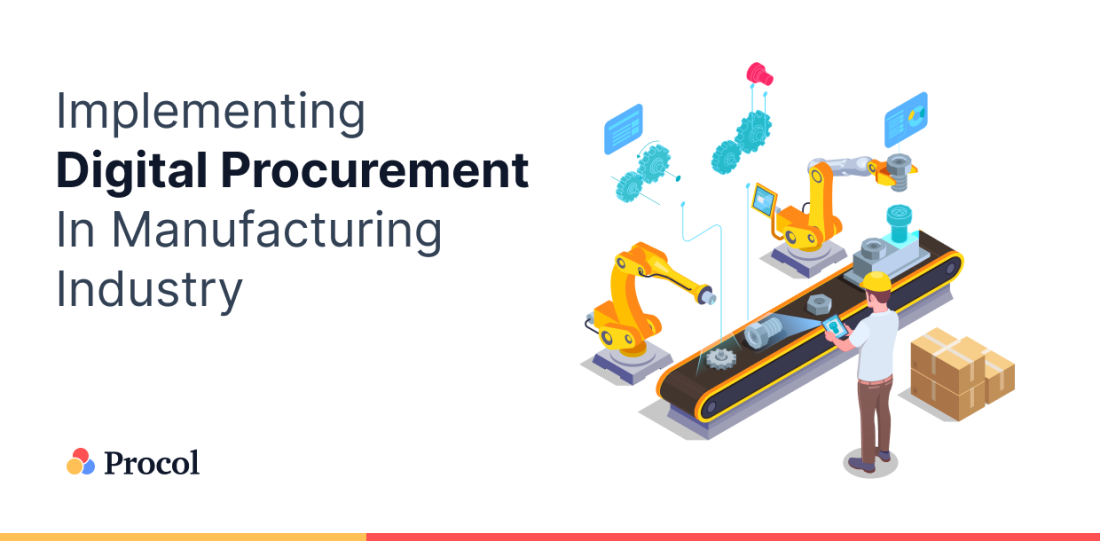Implementing Digital Procurement In Manufacturing Industry

When the COVID-19 pandemic hit, countries were forced to impose lockdown restrictions and the manufacturing industry suffered a huge loss. Every aspect of business had to embrace digital technology. Businesses that lagged, disappeared within a year because a sustainable supply chain is vital for the manufacturing industry. Before the pandemic, CPOs were happy with cost savings and operational efficiency. Now, procurement solutions in the manufacturing industry must support digital transformation, innovation, geopolitical stability, increasing societal pressures, a climate-conscious approach, and so much more.
Top Procurement Challenges in the Manufacturing Industry
CPOs continuously face procurement challenges, despite efforts to update the procurement process.
1. Risk Mitigation
Supplier risk is always challenging for the procurement team, which increased due to the pandemic. Apart from market risks, procurement leaders must also deal with delivery and compliance risks, potential fraud, loss of quality, and increased costs.
2. Maverick Spend
In any organisation, employees will have the authorisation to initiate purchases necessary to keep the business operations running. As a result, many low-value purchases don’t go through the procurement system, resulting in unclear purchases.
3. Lack Of Transparency
Facilitating procurement process transparency is always a problem when procurement processes are fragmented. Your procurement team has to refer to multiple spreadsheets to gather basic information. The sensitive information should not be shared with everyone. Maintaining transparency while ensuring data security is extremely difficult. As a result, procurement leaders don’t have visibility of all spending operations.
4. Data Inconsistencies
The manual entry becomes inevitable when multiple spreadsheets and emails are used for data sharing and communication. This results in data inconsistencies. This can be disastrous for profitable negotiations with suppliers. Incorrect procurement data will result in inventory shortage or overflowing inventory, which is challenging for manufacturing companies.
5. Extended Lead Times And Delays
Manual data entry results in a slower procurement process and extended lead times. During the dynamic manufacturing process, long-drawn procurement processes are not useful. Your organisation must implement a procurement solution to procure supplies on demand. Time delays not only disrupt the supply chain but also disrupt the manufacturing process.
How can E-Procurement help CPOs Overcome Challenges?
The procurement leaders must constantly redefine procurement strategies to keep up with the increasing demands. Those adopting procurement solutions can achieve business goals with greater efficiency and insight. Better procurement results in new product design, environmental sustainability, M&A synergy capture, new market entry, and much more. A comprehensive procurement system can help your organisation to reimagine and transform procurement in the following ways:
1. Improving Supply Chain Resilience
Supply chains are now interconnected as the global approach is preferred. While it opens doors for large-scale strategic sourcing, it also brings new challenges such as multipolar economic systems, climate changes, mass health care events, geopolitical risks, etc. According to a Mckinsey study, one in twenty companies has suffered a $100 million loss due to supply chain disruption in the past years. Automotive and technology manufacturers are the most affected industries because of the complex supply chain networks.
2. Develop Supplier Partnerships To Promote Innovation
Agility masters prefer a higher quality of stakeholder influence rather than quantity. The procurement solution helps you focus on customer management as an integral part of the procurement strategy. Organisations are moving towards a holistic supplier management approach instead of sourcing centric approach. Managed service providers become a part of the business ecosystem, thus becoming an enterprise extension. Deeper supplier partnerships forge strong relationships, directly resulting in business innovation.
3. Accelerate Digital Analysis
Procurement leaders are now aware of techniques to meet their savings targets. However, a Deloitte study shows that CPOs must focus on non-cost parameters for procurement analysis. E-procurement helps you derive accurate data analytics rapidly based on history. This analysis is useful for predicting demands. Currently, 18% of CPOs have access to a tier-1 supplier base and only 15% have visibility for suppliers in the lower tiers. Procurement software can come to the rescue and increase organisational transparency and visibility.
4. Improve Business Agility
The procurement department must adopt agile technologies to improve collaboration. Both internal and external stakeholders can communicate and collaborate effectively using the e-procurement platform. It enables rapid scaling up or down depending on the changing business needs. Agile strategies can be created for capturing value in the spend category or delivering contract negotiations, etc., depending on the assembly pipeline. The gamified procurement platforms enable procurement leaders to start using the platform quickly and easily.
5. Embrace Next-Generation Technologies
Organisations can enjoy success by investing in next-gen digital technologies. High-performing solutions can help in increasing automation by ten times. AI and ML technologies can be implemented effectively to use predictive and analytic solutions for procurement success.
Conclusion
Taking the first step towards a digital transformation is not easy for any organisation. However, newer procurement solutions cost less with minimal integration requirements. Cloud-based e-procurement platforms ease the overload on the IT department. An agile solution will solve the current procurement challenges while preparing for the business’s future.
Procol is the latest generation procurement software that can transform procurement in the manufacturing industry. Schedule a demo with us to learn how to implement next-gen procurement technology in just 7 days
Get a Free Demo
We'd love to hear from you. Please fill out this form to schedule a demo with us. You can also give a call on +91 76666 82222



